Blinded Palestinian Journalist Exposes Israel’s Increasing Violence Against Media
On November 15, Palestinian photojournalist Muath Amarneh covered a demonstration in Surif, a West Bank city where residents were protesting against the theft of their land by Israeli settlers. Wearing a press jacket and helmet, Amarneh was shot in the head by an Israeli bullet while taking pictures on a nearby hill — about 330 feet from the soldiers.
“Everything just changed. I felt the whole world was circling around me. And I felt my whole life flash before me. I felt like I was dying,” Amarneh said, describing his reaction when hit.
With blood dripping from his eye, Amarneh was taken to a hospital in Hebron, West Bank. He was eventually transported to Hadassah Hospital in Jerusalem where his left eye was removed. He remains there awaiting further operations to have the bullet removed from his head.
Videos and photos capturing Amarneh after the bullet pierced his eye went viral online. Using the hashtags #MuathEye, #EyeofTruth and #MuathAmarneh, “journalists across the world posted images of themselves with an eyepatch or one hand over their eye as a way to stand in solidarity with Amarneh.
Increasing Israeli violations against Palestinian press
After being shot, Israeli soldiers rushed to Amarneh claiming he wasn’t hit by one of their bullets but rather with stones thrown by protesters, but Amarneh was behind a line of demonstrators hurling stones.
“The army told me that, “This is not from us. This is from the people who are protesting and throwing stones. It’s the Palestinian who threw stones at you. It’s not a bullet from us,” Amarneh said.
Israeli police said they used “non-lethal means” to “disperse the rioters.” “The use of the non-lethal means was not directed at all at the photographer, and his injury could have been caused by the violent rioters,” Micky Rosenfeld, the Israeli police’s foreign press spokesperson, said.
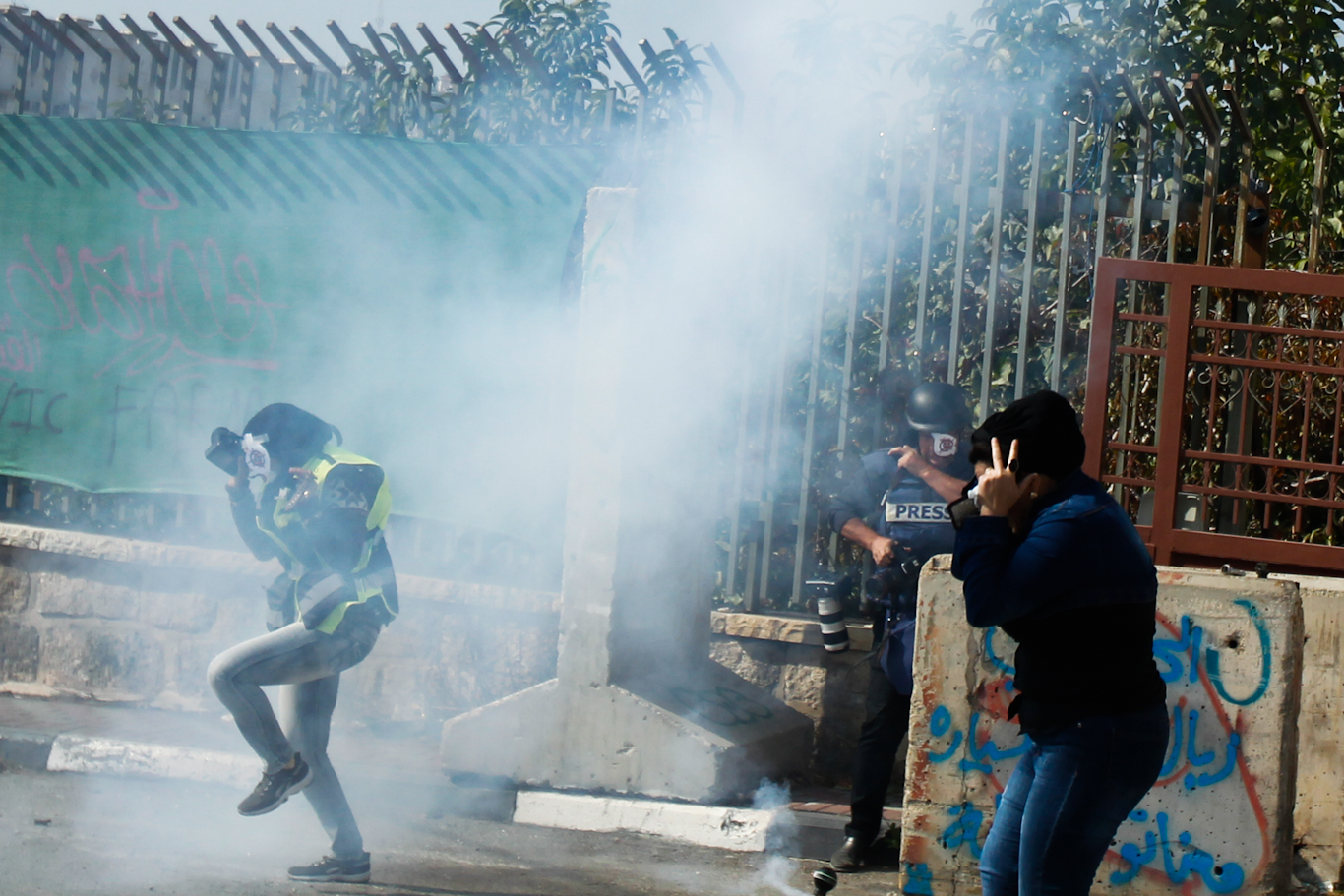
Palestinian journalists take cover from tear gas shot by Israeli police during a solidarity protest on November 17, 2019 in Bethlehem. Photo | Musa Al-Shaer
However, Amarneh believes he was directly attacked by Israeli forces.
Four days before Amarneh lost his eye, Omar al-Badawi was fatally shot by Israeli soldiers during clashes near Hebron. Video captured al-Badawi as he was shot in the chest by Israeli forces. Soldiers claimed they assumed al-Badawi was carrying a molotov cocktail, but he was merely holding a towel to extinguish a fire engulfing a tree near his home. Amarneh was one of the journalists who documented al-Badawi’s murder.
“After what happened, the Israeli army really doesn’t want journalists to show the world what’s going on,” Amarneh said. He feels that since al-Badawi’s killing was broadcast globally, the Israeli army is intensifying its crackdown on Palestinian journalists. He mentioned how an area in Bethlehem designated for journalists for years by the Israeli military is now an unwelcome location.
“This Thursday, they started telling journalists that if you stay in this place, we will arrest you,” Amarneh said, describing how the soldiers pushed the journalists and seized their cameras.
The following Sunday after Amarneh was shot, Palestinian journalists held a sit-in in Bethlehem to express their support. Israel Police dispersed the crowd using tear gas, with dozens of demonstrators suffocating from tear gas inhalation and seven individuals lightly wounded.
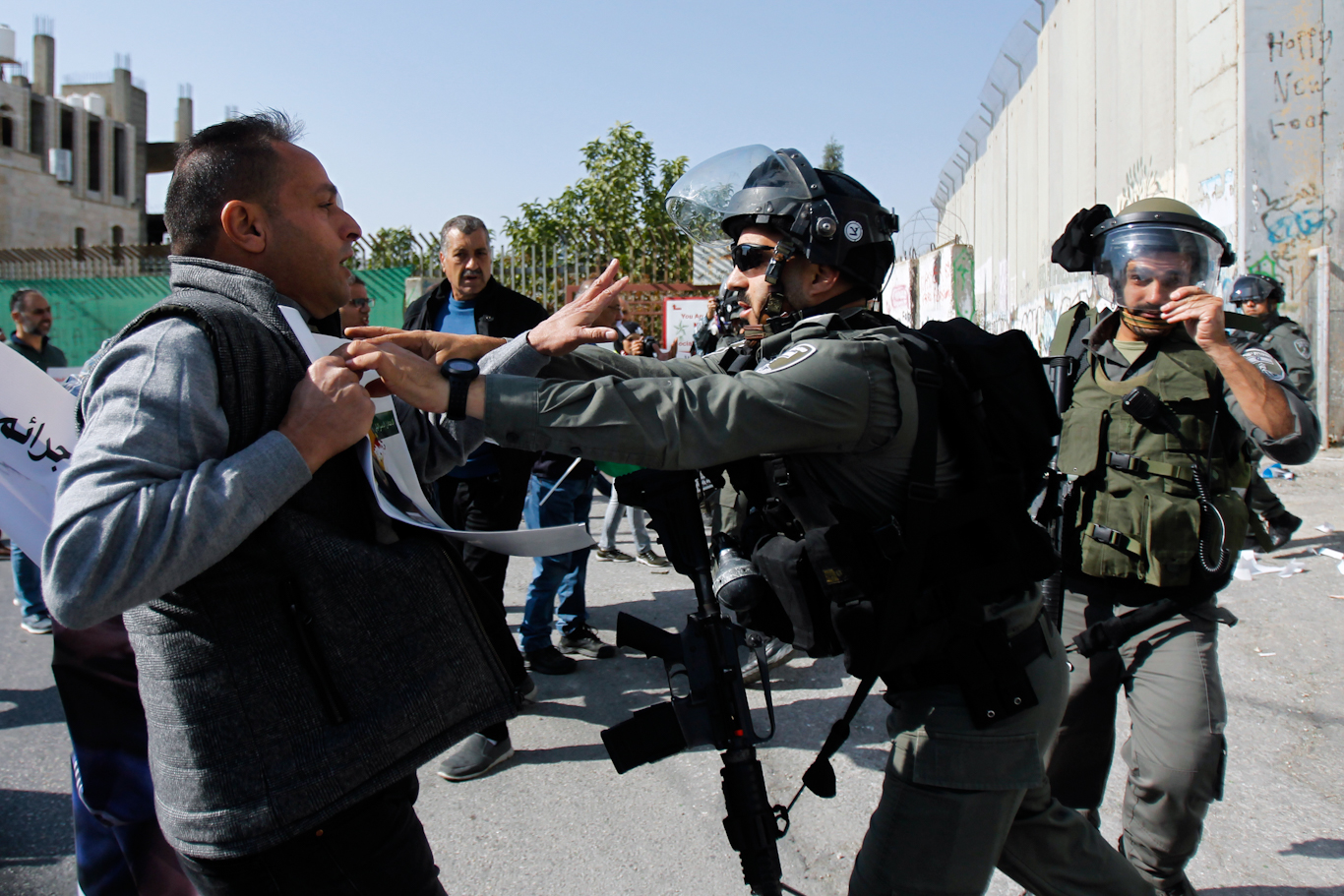
Israeli polcie grab a member of The Palestinian Journalists’ Syndicate during a solidarity protest on November 17, 2019, in Bethlehem. Photo | Musa Al-Shaer
On Wednesday, the Israeli army closed the office of Palestine Television in Jerusalem for six months after storming Al-ArzMedia Services Company which provides services to Palestine TV.
Mousa Rimawi, Director General of the Palestinian Center for Development and Media Freedoms (MADA), believes the Israeli army targeted Amarneh.
“I think they are targeting him. Witnesses say that. He said that. This is not the first time they are targeting journalists,” Rimawai said.
We saw it in Gaza, especially last year. When the Israeli army was targeting journalists, killing two of them and injuring tens of journalists by snipers.”
In 2018, Palestinian journalists Yasser Murtaja and Ahmad Hassan Abu Hussein were killed by Israeli snipers just one week apart from each other while covering the Great March of Return protests at the Gaza border.
According to The Palestinian Center Development and Media Freedoms (MADA), 455 Israeli violations and 129 Palestinian violations occurred against Palestinian journalists in 2018 — a more than 52 percent increase in the last two years. During the first half of 2019, 330 violations were documented against Palestinian media — a 19 percent increase from the same period last year. The majority of these violations comprise physical abuse, arrests or detentions, questioning, preventing coverage and shutting down websites and social media accounts.
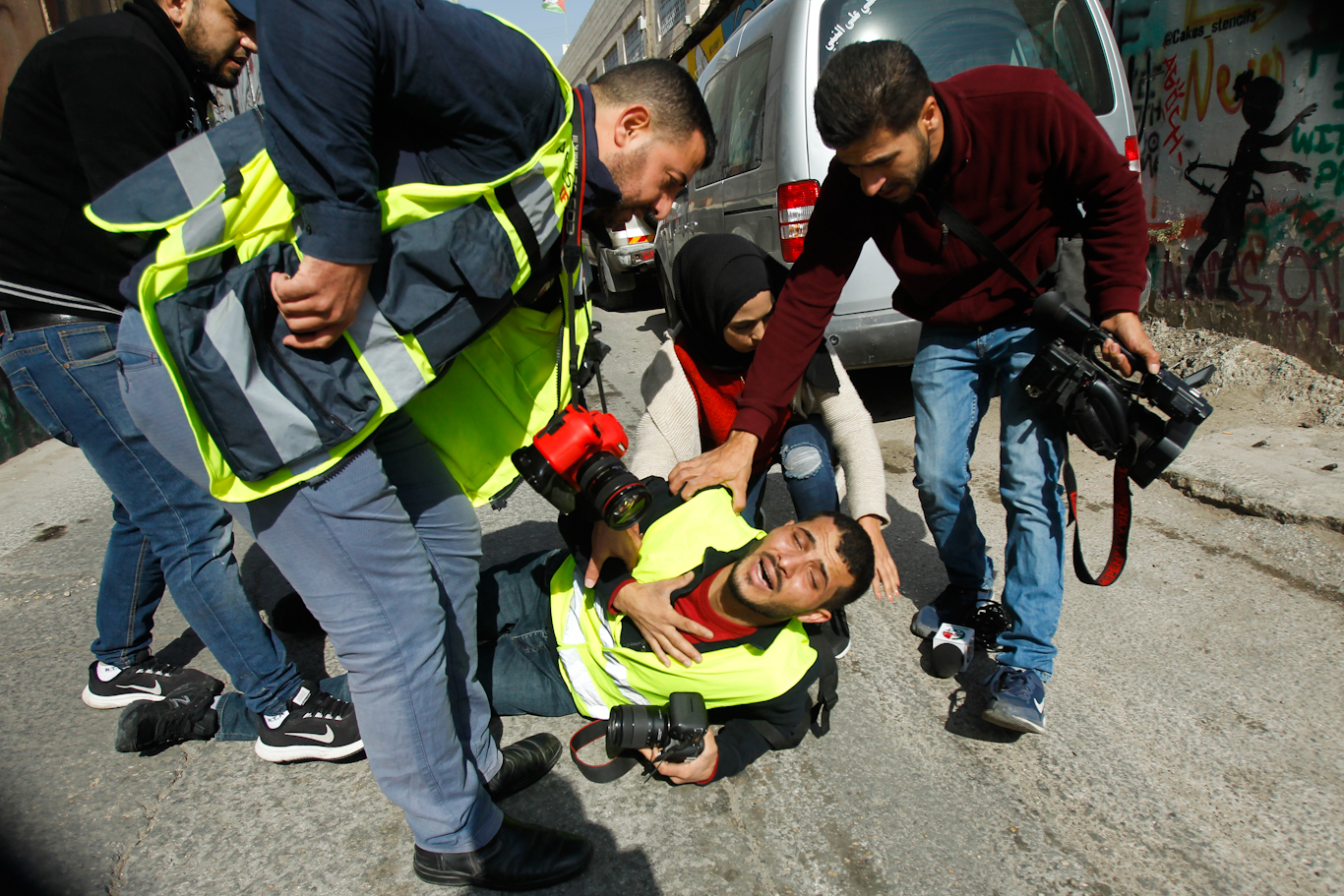
Palestinian journalists help a colleague injured during a solidarity protest on November 17, 2019 in Bethlehem. Photo | Musa Al-Shaer
“They want to silence this media who is covering the events relating to the Israeli occupation and to cover their crimes and daily practices in Palestine,” Rimawi said.
The Palestinian Journalists’ Syndicate (PJS) places the number of violations in 2019 higher, at more than 630, with 90 percent of reported attacks executed by Israel. Musa Al-Shaer, a board member of PJS, said MADA’s calculation is lower because they adjust the statistics in order to receive financial aid from the international community.
Facebook’s censorship of Palestinian media
Of the 330 documented violations by MADA, 65 of them were committed by Facebook. In 2016, the Israeli government and Facebook announced they were working together to combat incitement on social media. The driving force behind this partnership was Israel’s accusation that Palestinian violence is fueled by incitement online.
“After that announcement, Facebook began to block Palestinian sites for journalists and media outlets,” Rimawi said. He explained that Facebook has adopted Israel’s definition of incitement when deciding what content to censor. But going by Israel’s standards poses a problem for Palestinians.
“If someone posts a picture of a martyr, that’s incitement for Israelis, but for Palestinians that is normal. You could be posting a picture of your cousin who is a martyr,” Rimawi said.
Palestinians call those who died resisting the Israeli occupation “martyrs”, while Israelis refer to them as terrorists. He mentioned that words like Hamas (which literally translates to excitement in Arabic) and Qassam, the name of the military wing of Hamas, are consistently flagged. In some instances, a person named Qassam might end up with a deactivated Facebook account.
Facebook censorship of Palestinian media is increasing, and Israel appears to be the one steering the wheel. In 2017, 85 percent of Israeli government requests to “remove content deemed harmful or dangerous” was approved.
“We know Israel is pressuring other social media sites like Instagram and Twitter, but there are no agreements between them and Israel,” Rimawi said. “But with Facebook there is.”
Paving the way for Palestinian freedom of press
Amid a sharp rise in violations against Palestinian journalists, MADA is working with other civil society organizations to build a coalition to defend freedom of expression and digital freedom in Palestine. The coalition plans to tackle legislation, government policies, monitoring press freedom, Israeli violations and Facebook restrictions.
“It’s a good thing when people will not be silent, when countries will not be silent when there’s killing of journalists. But it must be linked with policies,” Rimawi said.
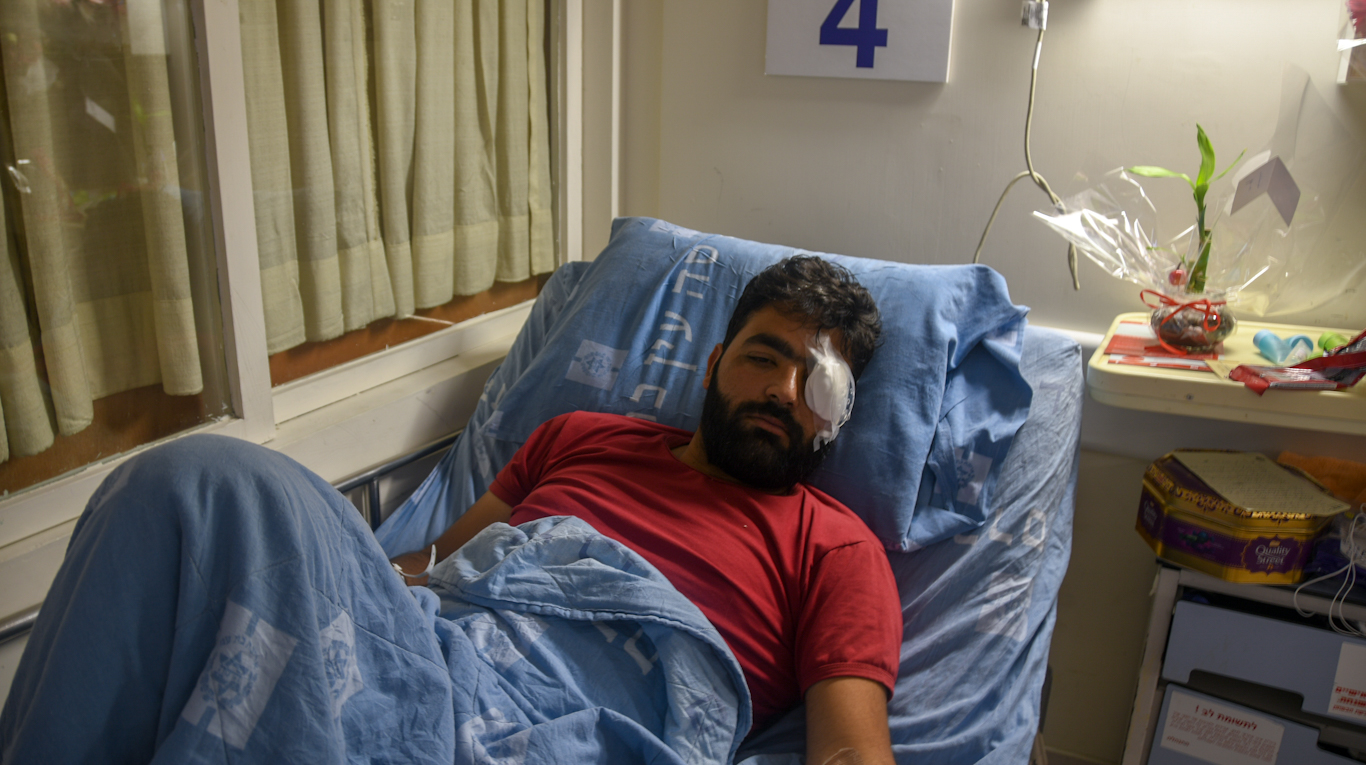
Palestinian photojournalist Muath Amarneh lies injured in his hospital bed in Jerusalem. Photo | Delilah Boxstein
Amarneh has frequently experienced Israeli abuse in his ten years of working as a journalist. He was previously shot multiple times by rubber bullets on the lower parts of his body and fired at by water cannons. But this recent attack was the most severe.
Amarneh is currently focused on his recovery but asserts he will seek legal action when he is healed. Despite the trauma of losing his eye, he still plans to continue reporting.
“I won’t stop being a journalist but now I feel unsafe,” Amarneh said. “They could attack my other eye. It will be harder for me to continue what I am doing.”
Feature photo | Palestinian photojournalist Mu’ath Amarneh, seated on the left, moments after being shot in the left eye by an Israeli soldier in Surif, West Bank on November 15, 2019. Photo | Palestinian Information Center
The views expressed in this article are the sole responsibility of the author and do not necessarily reflect those of the Blog!
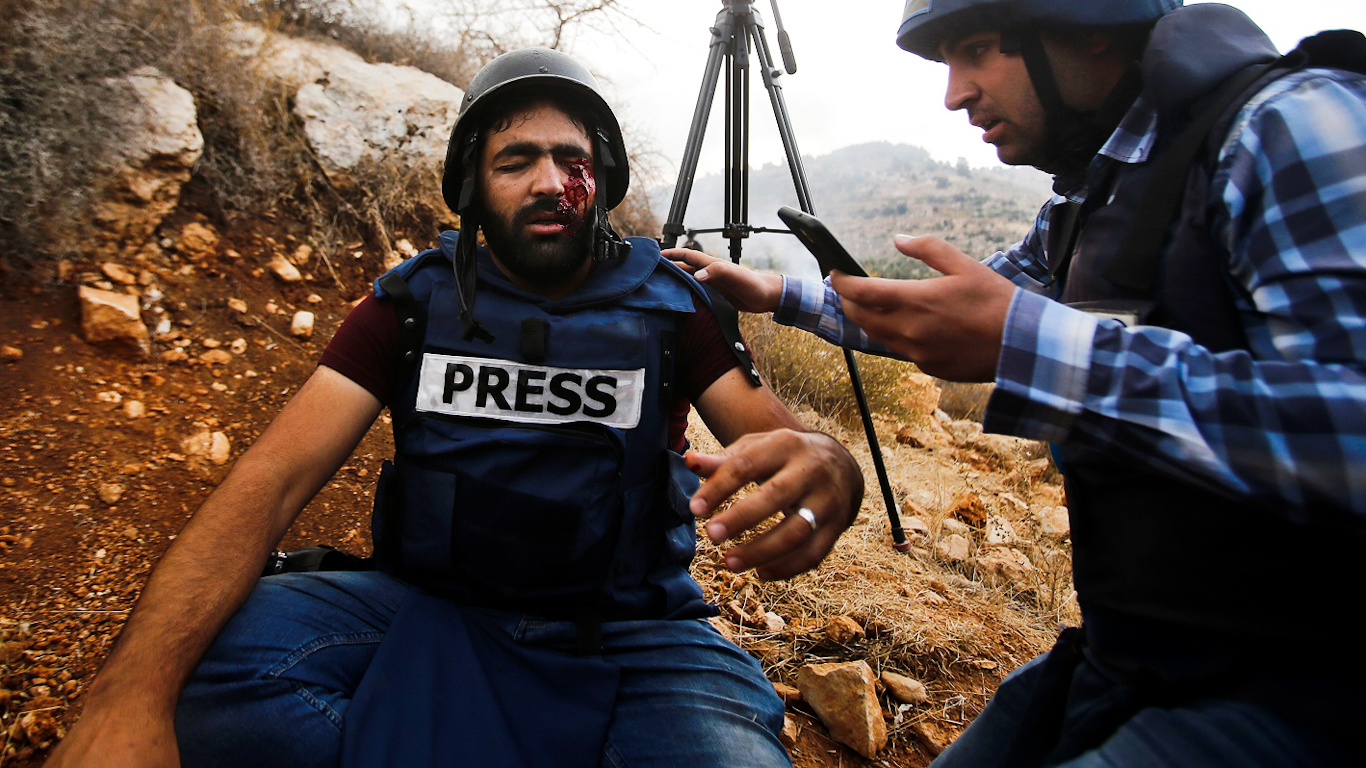

No comments:
Post a Comment